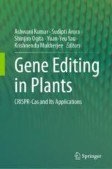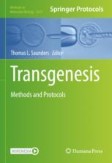Search
Search Results
-
One-Step Genoty** Method in loxP-Based Conditional Knockout Mice Generated by CRISPR-Cas9 Technology
With the development of CRISPR-Cas9 gene editing and in vitro fertilization (IVF) technology, we can now easily construct genetically modified mouse...

-
A Cre-LoxP-based approach for combinatorial chromosome rearrangements in human HAP1 cells
Alterations of human karyotype caused by chromosomal rearrangements are often associated with considerable phenotypic effects. Studying molecular...

-
Recycling selectable markers via Cre/loxP system for constructing Komagataella phaffii strains co-expressing multiple proteins
ObjectiveA convenient strategy was developed to recycle selectable markers using Cre/ loxP system for constructing Komagataella phaffii strains...

-
Improving Sedum plumbizincicola genetic transformation with the SpGRF4–SpGIF1 gene and the self-excision CRE/LoxP system
Main conclusionS. plumbizincicola genetic transformation was optimized using a self-excision molecular-assisted transformation system by integrating...

-
Orthogonal LoxPsym sites allow multiplexed site-specific recombination in prokaryotic and eukaryotic hosts
Site-specific recombinases such as the Cre-LoxP system are routinely used for genome engineering in both prokaryotes and eukaryotes. Importantly,...

-
VCre/VloxP and SCre/SloxP as Reliable Site-Specific Recombination Systems for Genome Engineering
The Cre/loxP system is a versatile and powerful tool that has been used to develop many kinds of genetically modified mice, such as conditional...
-
Introduction of loxP sites by electroporation in the mouse genome; a simple approach for conditional allele generation in complex targeting loci
BackgroundThe discovery of the CRISPR-Cas9 system and its applicability in mammalian embryos has revolutionized the way we generate genetically...

-
Keratinocyte-specific knockout mice models via Cre–loxP recombination system
Purpose of reviewThe Cre recombinase/loxP (Cre/loxP) system has emerged as a useful tool in genetic manipulations. Generally, any DNA sequence of...

-
Fast and efficient generation of a full-length balancer chromosome by a single Cre/loxP recombination event
Balancer chromosomes, primarily discovered and used in Drosophila melanogaster , are valuable tools to maintain lethal mutations in a particular...

-
Combined Use of Unidirectional Site-Specific Recombination System and CRISPR-Cas Systems for Plant Genome Editing
Site-specific recombination (SSR) systems have been extensively used for controlled genome modification in eukaryotic cells, especially for DNA...
-
A new suite of reporter vectors and a novel landing site survey system to study cis-regulatory elements in diverse insect species
Comparative analyses between traditional model organisms, such as the fruit fly Drosophila melanogaster , and more recent model organisms, such as the...

-
Generation of Floxed Mice by Sequential Electroporation
Generation of conditional knockout mice using the Cre-loxP system is essential for the analysis of gene functions. The use of CRISPR-Cas9 in...
-
Correction to: The development of genome editing tools as powerful techniques with versatile applications in biotechnology and medicine: CRISPR/Cas9, ZnF- and TALE-nucleases, RNA interference and Cre/loxP
We regret the incorrect designation of the site attacking the 3′-phosphotyrosine as 3′-hydroxyl group in the process following the formation of the...

-
Lineage Tracing of Bone Cells in the Regenerating Fin and During Repair of Bone Lesions
Small teleost fishes such as zebrafish and medaka show remarkable regeneration capabilities upon tissue injury or amputation. To elucidate cellular...
-
Floxing by Electroporating Single-Cell Embryos with Two CRISPR RNPs and Two ssODNs
Floxed alleles and Cre drivers are two components of most conditional knockout mouse models, which are not only important for studying a given gene...
-
Targeted insertion of conditional expression cassettes into the mouse genome using the modified i-PITT
BackgroundTransgenic (Tg) mice are widely used in biomedical research, and they are typically generated by injecting transgenic DNA cassettes into...

-
The Q/R editing site of AMPA receptor GluA2 subunit acts as an epigenetic switch regulating dendritic spines, neurodegeneration and cognitive deficits in Alzheimer’s disease
BackgroundRNA editing at the Q/R site of GluA2 occurs with ~99% efficiency in the healthy brain, so that the majority of AMPARs contain GluA2(R)...

-
Multigene Transformation Through Cre-lox Mediated Site-Specific Integration in Rice
Plant transformation with multiple genes is a major challenge, rendering multi-trait engineering extremely difficult in crop plants. One of the...
-
Biolistic Transformation of Cryptococcus neoformans
Biolistic transformation of Cryptococcus neoformans is used as a molecular tool to genetically alter or delete targeted genes. The DNA is introduced...
-
Application of RecET-Cre/loxP system in Corynebacterium glutamicum ATCC14067 for l-leucine production
ObjectiveTo explore the RecET-Cre/ loxP system for chromosomal replacement of promoter and its application on enhancement l -leucine production in Coryn...

